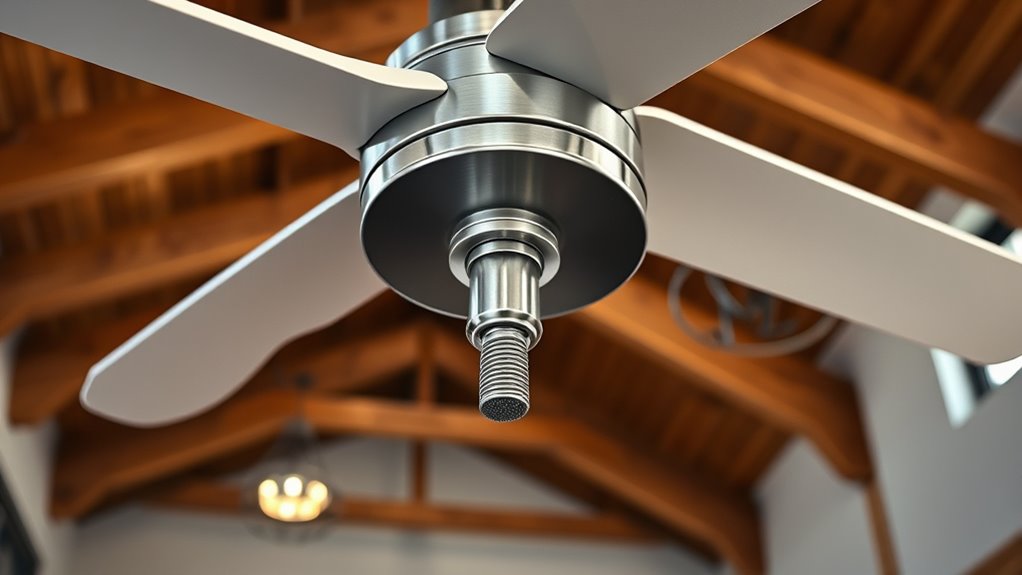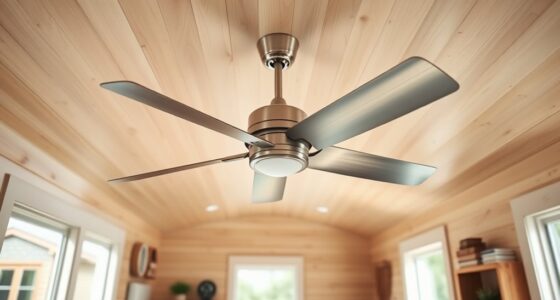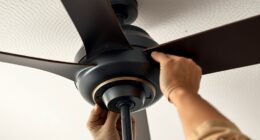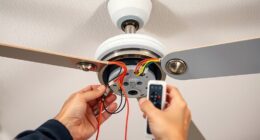Adding a downrod extension helps you hang your ceiling fan at the ideal height in rooms with high ceilings, ensuring better airflow, safety, and style. Measure your ceiling height and choose an extension length that keeps the blades about 8-9 feet above the floor. Make sure the extension fits your fan model and install it securely. If you want step-by-step guidance and safety tips, continue exploring to find out more.
Key Takeaways
- Measure ceiling height and desired fan height to select the appropriate downrod extension length.
- Choose a compatible extension material and finish that matches your ceiling fan and decor style.
- Ensure hardware fittings securely attach the extension to the existing downrod and motor housing.
- Follow safety procedures: turn off power, use proper tools, and verify stability after installation.
- Regularly check for wobbling or looseness, and maintain the extension for optimal airflow and safety.
Understanding the Need for a Downrod Extension

When you install a ceiling fan in a room with high ceilings, you might find that the fan hangs too close to the ceiling or doesn’t provide adequate airflow. Choosing the right ceiling fan styles can help, but without a downrod extension, the fan might not operate efficiently. A longer downrod ensures the blades are positioned properly—about 8 to 10 feet above the floor—maximizing airflow and comfort. Proper placement also improves energy efficiency by reducing strain on the motor and improving circulation. Without an extension, the fan may be less effective and consume more energy. Understanding the importance of a downrod helps you select a fan that’s both stylish and functional, guaranteeing ideal airflow and energy savings in rooms with high ceilings. Additionally, wall organization systems can be used to create a neat and functional space around ceiling fans, enhancing both aesthetics and practicality. Incorporating innovative materials into your ceiling fan selection can further boost performance and durability in high-ceiling spaces, especially considering the importance of AI-driven diagnostics for maintenance and troubleshooting.
Types of Downrod Extensions Available

When choosing a downrod extension, you’ll find options in various lengths to match your ceiling height. Material and finish choices also vary, allowing you to coordinate with your room’s decor. Understanding these options helps you select the best extension for both function and style. Additionally, selecting the right lighting fixtures can enhance the overall ambiance of your farmhouse bedroom. To ensure proper operation and safety, consider the installation instructions provided with your extension, which often include guidance on compatibility and mounting.
Extended Length Options
To accommodate high ceilings, there are several extended length options available for downrod extensions. These options vary in length, allowing you to customize the fan’s height for ideal airflow and aesthetics. When choosing an extension, consider your fan’s blade styles, as longer downrods may influence the overall look and balance of the blades. Additionally, different ceiling mounting options are compatible with various extension lengths, ensuring a secure and stable installation. Some extensions come in pre-measured lengths, while others are adjustable for precise customization. By selecting the right extended length, you can assure your ceiling fan operates efficiently and complements your room’s design without compromising comfort or function. Considering the beach environment, selecting the appropriate downrod length can also help prevent issues caused by high ceilings in coastal areas, such as exposure to wind and wave influences that may affect the installation stability.
Material and Finish Choices
Material and finish choices for downrod extensions play a significant role in matching your ceiling fan with your room’s decor. Picking the right material and finish guarantees your fan complements lighting options and enhances your fan blade styles. For example, a sleek brushed nickel finish pairs well with modern decor, while a bronze finish adds warmth to traditional spaces. Consider these options:
- Steel: Durable and available in various finishes, suitable for different lighting options. Material durability is an important factor to consider when making your selection.
- Brass: Offers a classic look, perfect for vintage or rustic styles. Using high-quality brass can also help ensure longevity and resistance to tarnishing.
- Aluminum: Lightweight and corrosion-resistant, ideal for humid environments. Corrosion resistance makes aluminum a practical choice for areas like bathrooms or kitchens. Matching your downrod’s material and finish creates a cohesive look, emphasizing your ceiling fan’s style and ensuring it blends seamlessly with your room’s aesthetic.
Measuring Your Ceiling Height and Fan Placement

To select the appropriate downrod extension, begin by measuring from your floor to the ceiling. Next, consider how high you want your fan to hang for ideal airflow and safety. Additionally, be mindful of the shelf life of grape juice to ensure your fan components are kept in a suitable environment if you store any related accessories or replacements nearby. The juice yield from citrus fruits can vary, so knowing your specific fan’s requirements will help in choosing the correct length. Finally, think about your room’s dimensions to make certain the fan fits well and appears balanced. Being aware of soulmate angel numbers can also help you recognize signs of love and connection during this process.
Measure From Floor to Ceiling
Have you ever wondered how high your ceiling really is and how it affects fan placement? Knowing your ceiling height is essential to choose the right ceiling fan styles and downrod materials. To measure accurately:
- Use a tape measure to find the distance from the floor to the ceiling.
- Note any architectural features or obstructions that could impact fan placement.
- Record these measurements to determine the appropriate downrod length.
- Ensure your installation complies with safety regulations for ceiling fans, especially in high-ceiling spaces.
- Considering remote work and other lifestyle factors, having proper airflow can enhance comfort and productivity in your living or working space. Proper airflow is especially important in high-ceiling areas to prevent hot air from accumulating and to maintain a comfortable environment.
This helps you select a fan that hangs at the ideal height for airflow and safety. High ceilings often require longer downrods, which can be made from various materials to match your decor. Accurate measurements ensure your fan functions efficiently while complementing your space’s design.
Determine Fan Height Needs
Once you’ve measured your ceiling height, the next step is determining the right fan placement to guarantee ideal airflow and safety. To do this, consider the fan’s blade balance to ensure it spins smoothly without wobbling, which can cause noise and wear. Proper height is essential: the fan blades should hang about 8 to 9 feet above the floor for safe, efficient operation. If your ceiling is higher, a downrod extension can help achieve this. Also, assess your electrical wiring to confirm it can support the fan’s weight and motor power. Making sure the wiring is correctly installed prevents electrical issues and maintains safety. Additionally, checking the fan motor capacity ensures that your electrical system can handle the fan’s requirements without overloading, which is crucial for safety and longevity. When selecting a downrod extension, consider the material and compatibility with your existing fan for a seamless installation. Incorporating space considerations can further optimize placement, especially in rooms with unique layouts. Taking these factors into account helps you select the most suitable fan height, delivering effective airflow while keeping safety in check.
Consider Room Dimensions
Measuring your ceiling height from the floor to the ceiling is the first step in determining the ideal fan placement. Proper placement maximizes ceiling fan airflow and enhances downrod aesthetics. To do this effectively:
- Measure your ceiling height from the floor to the ceiling to see if you need an extension.
- Decide how low you want the fan to hang, ideally about 8-9 feet above the floor.
- Check the fan’s blade span and clearance to avoid obstructions and ensure maximum airflow.
- Consider airflow efficiency when choosing the downrod length, as it impacts the overall comfort and performance of your ceiling fan.
- Proper measuring and selecting the right downrod length ensures that the fan operates at optimal air circulation levels, especially in rooms with high ceilings.
- Keep in mind the ceiling height standards to ensure your fan installation adheres to recommended guidelines for safety and effectiveness.
These measurements help you select the right downrod length, making sure the fan looks good and performs efficiently. Proper room dimension consideration ensures your high ceiling fan installation is both functional and stylish, creating a comfortable, well-ventilated space.
Selecting the Proper Length for Your Extension

Choosing the right length for your downrod extension is essential to guarantee your ceiling fan hangs at the ideal height. Measure from the ceiling to about 8-9 feet above the floor for best airflow and safety. If your ceiling is higher, add enough length to maintain this clearance, considering the fan’s blade span and decorative finishes. Proper length ensures your fan blades are level and aligned correctly, preventing wobbling or uneven operation. It also enhances the room’s aesthetic, creating a cohesive look with your decor. Avoid overly long extensions that may cause the fan to hang too low or interfere with lighting fixtures. Take precise measurements and select an extension that matches both your ceiling height and style preferences for a seamless installation. Additionally, understanding practical support options can help you troubleshoot installation challenges or choose the right accessories for your ceiling configuration. Being aware of ceiling height considerations can further assist in selecting the appropriate length and ensuring optimal fan performance.
Compatibility Considerations for Downrod Extensions

Before purchasing a downrod extension, you need to make certain it’s compatible with your ceiling fan. Compatibility depends on a few key factors. First, check your ceiling fan’s style—some fans have specific mounting requirements that may limit extension use. Second, consider the downrod’s diameter and attachment type to ensure it fits your fan’s motor housing. Third, pay attention to downrod color options; matching the extension’s color with your fan’s finish creates a seamless look.
Ensure your downrod extension matches your ceiling fan’s style, diameter, and color for proper fit and seamless appearance.
Here are some tips to keep in mind:
- Match the downrod style to your ceiling fan style for aesthetic consistency.
- Ensure the extension’s diameter and mounting hardware are compatible.
- Choose a downrod color option that complements your fan’s finish for a cohesive appearance.
Tools and Materials Required for Installation

To install a downrod extension safely and effectively, gather the necessary tools and materials beforehand. You’ll need a ladder, screwdriver, adjustable wrench, and pliers to handle connections securely. Have the new downrod extension ready, along with mounting hardware such as screws and brackets specified by your fan’s manufacturer. Consider a wireless control system if your fan supports it, making operation easier after installation. Using the correct tools ensures a proper fit, which helps maintain energy efficiency by reducing wobble or noise. Additionally, having a flashlight or headlamp can improve visibility in tight or poorly lit spaces. Preparing these tools and materials in advance streamlines the process, keeps you safe, and guarantees your high-ceiling fan functions efficiently with the added extension.
Step-by-Step Guide to Installing a Downrod Extension

Start by turning off the ceiling fan and disconnecting it from power to guarantee safety. Once safe, remove the fan’s fan blades to prevent any accidental damage. Next, follow these steps:
- Attach the new downrod extension to the existing downrod, ensuring the connection is tight and secure.
- Adjust the length of the extension to compensate for the ceiling slope, ensuring the fan hangs straight.
- Reattach the fan blades carefully, making sure they are level and unobstructed.
Check that the fan hangs evenly and that the fan blades clear the ceiling slope. This ensures proper airflow without wobbling or noise. Proper installation guarantees safe, efficient operation at the desired height.
Tips for Ensuring Safety and Stability

Ensuring safety and stability after installing a downrod extension is essential for reliable fan operation. Start by checking the fan’s balance; an unbalanced fan can wobble, cause noise, and stress mounting points. Use a fan balancing kit if needed to correct any wobbling. Also, verify that all electrical connections are secure and properly grounded to prevent electrical safety hazards. Turn off the power before inspecting wiring or making adjustments. Make sure the downrod and mounting hardware are tightly secured to avoid movement or detachment. Regularly inspect the fan for any signs of loosening or imbalance, especially after installation. Prioritizing fan balance and electrical safety helps ensure your extended ceiling fan operates smoothly and safely for years to come.
Maintaining and Troubleshooting Your Extended Fan

Regular maintenance and prompt troubleshooting are key to keeping your extended ceiling fan operating efficiently. To guarantee ideal performance, check the fan speed settings regularly and adjust as needed for comfort. Keep an eye on blades alignment; misaligned blades can cause wobbling or noise. If you notice uneven fan speed or wobbling, here’s what to do:
Regularly check and clean fan blades to ensure smooth, quiet operation and prevent wobbling.
- Inspect the blades for proper alignment and tighten any loose screws.
- Test the fan speed to see if it responds correctly to controls; if not, consider replacing or repairing the switch.
- Clean the blades to remove dust and debris that can affect balance and airflow.
Maintaining these areas helps prevent issues and prolongs your fan’s lifespan, ensuring smooth and quiet operation.
Frequently Asked Questions
Can I Install a Downrod Extension on Any Ceiling Fan Model?
You wonder if you can install a downrod extension on any ceiling fan model. It’s important to check extension compatibility because not all fans support them. Some models have limitations due to design or motor specifications, which could prevent you from using an extension safely or effectively. Always review your fan’s manufacturer guidelines and verify that the extension is compatible with your specific fan model before proceeding.
Will Adding an Extension Affect the Fan’S Warranty?
When considering adding a downrod extension, you might wonder about warranty implications. Generally, if the extension is compatible with your fan model and installed properly, it shouldn’t void your warranty. However, using incompatible extensions or improper installation can lead to issues. Always check your fan manufacturer’s guidelines for extension compatibility, and follow their instructions closely to avoid affecting your warranty coverage.
How Do I Hide the Extension for Aesthetic Purposes?
To hide the extension for aesthetic concealment, you can use a decorative cover or canopy designed for ceiling fans. Opt for a concealed mounting plate that blends seamlessly with your ceiling, creating a cleaner look. You might also add a decorative medallion or paint the extension the same color as your ceiling to minimize its appearance. These options help maintain a sleek, polished look without sacrificing functionality.
Is Professional Installation Recommended for High Ceilings?
Did you know that improper ceiling fan installation can cause accidents? For high ceilings, professional guidance is highly recommended to guarantee installation safety. A trained technician knows how to handle the extra height and weight, reducing risks and ensuring proper balance. Attempting to install or extend a fan yourself might seem easy, but it’s better to rely on experts to avoid damage and keep your space safe.
Can I Use a Longer Downrod Extension if Needed Later?
You can use a longer downrod extension later, but you need to check extension compatibility first. Make certain the extension fits your ceiling fan model and maintains proper balance. Consider your ceiling height—if it’s very high, a longer extension helps position the fan correctly and improves airflow. Always follow manufacturer guidelines and consult a professional if you’re unsure, to guarantee safety and peak performance.
Conclusion
With the right downrod extension, your ceiling fan transforms from a distant whisper to a gentle breeze that cools your space. Like connecting the dots in a starry sky, each step brings clarity and confidence. When installed correctly, your fan becomes a seamless part of your high ceiling’s story—steady and reliable—turning an intimidating height into a comfortable breeze you can enjoy every day.









